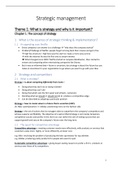Samenvatting
Volledige samenvatting Strategic Management
- Instelling
- Universiteit Antwerpen (UA)
Volledige samenvatting Strategic Management Vak wordt gegeven in Masterjaar (o.a. richting Organisatie & Management) Samenvatting bevat alle PowerPoint slides aangevuld met notities vanuit de les
[Meer zien]



